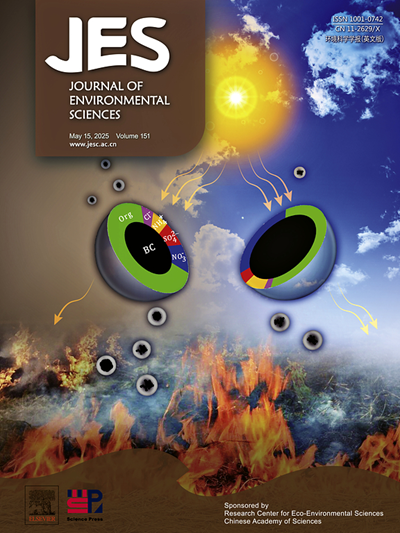Rapid formation of acetaldehyde and its influence on ozone formation in a petrochemical industrialized region
IF 5.9
2区 环境科学与生态学
Q1 ENVIRONMENTAL SCIENCES
引用次数: 0
Abstract
Acetaldehyde plays a significant role in atmospheric photochemical reactions and ozone formation. Previous studies have shown that acetaldehyde may rapidly be generated over short periods and impact ozone production, yet the underlying mechanism remains unclear. To better elucidate these mechanisms, a field campaign was conducted in Dongying, a typical petrochemical city in China. The observed acetaldehyde concentration averaged 3.0 ± 1.6 ppbv, with a peak around 09:00 local time. The diurnal variations of acetaldehyde were categorized into two types, with Category 1 exhibiting relatively high values and increasing sharply in concentration between 07:00 and 09:00 a.m. (refer to morning peak episode, MPE), and the remaining classified as Category 2. Category 1 was similar to previous studies at heavily polluted sites but differed from cleaner locations. Using an observation-based chemical box model, we found that acetaldehyde contributed an average of 10.2 % to the net ozone production rate. Combined with a positive matrix factorization model, we identified secondary formation as the dominant source of acetaldehyde (45.0 %), and the daytime production rate of acetaldehyde in Category 1 was significantly higher than that in Category 2. Cis-2-butene and trans-2-butene were identified as key precursors for the rapid acetaldehyde formation during the MEP, with the petroleum industry being their primary source. Volatile organic compounds (VOCs) from petroleum industry contributed over 60 % to acetaldehyde formation during the morning peak. Our findings underscore the urgent need for targeted VOCs management strategies in petroleum sector to mitigate both carbonyl and ozone formation.

某石化工业区内乙醛的快速生成及其对臭氧形成的影响
乙醛在大气光化学反应和臭氧形成中起着重要作用。先前的研究表明,乙醛可能在短时间内迅速产生并影响臭氧的产生,但其潜在机制尚不清楚。为了更好地阐明这些机理,在中国典型的石化城市东营进行了实地考察。观测到的乙醛浓度平均为3.0±1.6 ppbv,在当地时间09:00左右达到峰值。乙醛的日变化被分为两类,第一类表现出相对较高的值,并且在上午07:00至09:00之间浓度急剧增加(参考早高峰集,MPE),其余的被分类为第二类。第一类与之前在污染严重的地点进行的研究类似,但与较清洁的地点不同。使用基于观测的化学箱模型,我们发现乙醛对净臭氧生成速率的平均贡献为10.2%。结合正矩阵分解模型,我们确定二次生成是乙醛的主要来源(45.0%),并且第一类乙醛的白天产量明显高于第二类乙醛。顺式-2-丁烯和反式-2-丁烯被确定为MEP期间乙醛快速形成的关键前体,石油工业是它们的主要来源。在早高峰期间,来自石油工业的挥发性有机化合物(VOCs)贡献了超过60%的乙醛形成。我们的研究结果强调了石油行业迫切需要有针对性的VOCs管理策略,以减少羰基和臭氧的形成。
本文章由计算机程序翻译,如有差异,请以英文原文为准。
求助全文
约1分钟内获得全文
求助全文
来源期刊

Journal of Environmental Sciences-china
环境科学-环境科学
CiteScore
13.70
自引率
0.00%
发文量
6354
审稿时长
2.6 months
期刊介绍:
The Journal of Environmental Sciences is an international journal started in 1989. The journal is devoted to publish original, peer-reviewed research papers on main aspects of environmental sciences, such as environmental chemistry, environmental biology, ecology, geosciences and environmental physics. Appropriate subjects include basic and applied research on atmospheric, terrestrial and aquatic environments, pollution control and abatement technology, conservation of natural resources, environmental health and toxicology. Announcements of international environmental science meetings and other recent information are also included.
 求助内容:
求助内容: 应助结果提醒方式:
应助结果提醒方式:


